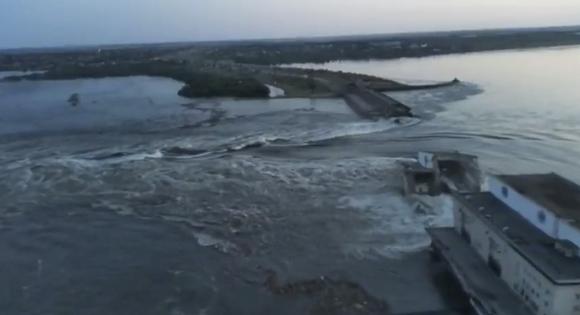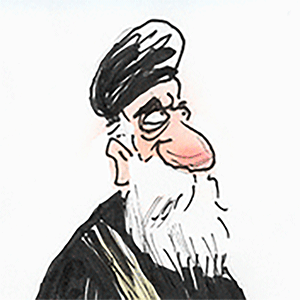Kakhovka dam breach: 3 essential reads on what it means for Ukraine's infrastructure, beleaguered nuclear plant and future war plans
Published in Political News
A dam that supplies drinking water to thousands of Ukrainians as well as cooling water for reactors at the Zaporizhzhia Nuclear Power Station was ruptured on June 6, 2023.
Kyiv blamed the destruction on Moscow, with President Volodymyr Zelenskyy slamming “Russian terrorists” for destroying the Kakhovka dam and the adjacent hydroelectric power station on the Dnieper River. Meanwhile, the Kremlin accused Ukraine of “deliberate sabotage,” noting that the reservoir is a crucial resource for the people of Crimea, a Ukrainian region illegally annexed by Russia in 2014.
Either way, the destruction of the dam is a worrying development. It has the potential for lasting ecological damage and harm to human health in a country already ravaged by more than a year of warfare. It also evokes concerns flagged by The Conversation’s authors in past articles looking at how the conflict has put infrastructure and nuclear power on the front lines.
This isn’t the first time during the Ukraine war that concerns have been raised over the fate of the Zaporizhzhia Nuclear Power Station. The plant is the largest nuclear facility in Europe. But ongoing fighting has put it in a uniquely vulnerable position.
In an interview back in August 2022 after the plant was damaged by shelling, Najmedin Meshkati, a nuclear safety expert at the University of Southern California, laid out the concerns, including a worst-case scenario in which a missile damages the nuclear reactor, releasing radiation into the atmosphere. “It could be another Chernobyl,” he said.
More pertinent to the destruction of the dam is the potential disruption to the flow of cooling water.
As Meshkati pointed out in August 2022: “Even if you shut down the reactors, the plant will need off-site power to run the huge cooling system to remove the residual heat in the reactor and bring it to what is called a cold shutdown. Water circulation is always needed to make sure the spent fuel doesn’t overheat. Spent fuel pools also need constant water circulation to keep them cool, and they need cooling for several years before they can be put in dry casks.”
The International Atomic Energy Agency has said in the aftermath of the dam rupture that there are no immediate risks to the Zaporizhzhia Nuclear Power Station. It noted that five of the six reactors there have already been put in cold shutdown, which require relatively little water. The sixth reactor is cooled with water from a nearby pond. The danger would be if the pond became depleted.
These concerns may prompt renewed calls for a demilitarized zone to be set up around the nuclear plant.
“War,” Meshkati noted, “is the worst enemy of nuclear safety.”
Read more:
Russia has denied causing the damage to the dam. But in October 2022, Benjamin Jensen, a defense strategist at American University’s School of International Service, was warning of the danger of increased targeting of civilian infrastructure as the war progressed.
In response to setbacks on the battlefield, “Russia has increased its attacks in Ukraine on everything from power plants and dams to railways, pipelines and ports,” he noted, adding, “These attacks against civilian infrastructure are not random. Rather, they reflect an insidious calculus integral to modern Russian military theory. For more than 20 years, Russian military journals have emphasized the need to conduct noncontact warfare and target critical infrastructure.”
It forms part of a “coercive strategy” by which Russia attempts to manipulate the enemy through a mix of political, economic and military pressure.
After it became apparent that Russia’s initial war plan was sufficiently countered by Western-backed Ukrainian resistance, Moscow upped its attacks on infrastructure in line with this coercive strategy.
“While military campaigns historically target transportation infrastructure, Russia went further. In response to the ongoing counteroffensive – which has seen Ukrainian forces retake formerly Russian occupied land in the east and south of the country – coercive measures by Russia have escalated to include targeting major dams. In mid-September 2022, Russia tried to destroy the dam outside of Kryvyi Rih, a city of half a million people,” wrote Jensen.
If the Ukrainian interpretation of what happened at the Kakhovka dam is accepted, this time, Russia succeeded.
Read more:
Regardless of who is to blame over the dam’s rupture, the incident will affect the war.
Stefan Wolff and David Hastings Dunn, from the University of Birmingham in the U.K., noted the timing of the destruction: just as Ukraine seemed poised to launch a major counteroffensive.
“The enormous flood that it has triggered is likely to devastate vast areas on both banks of the Dnieper south toward Crimea. This will make offensive operations by Ukrainian ground forces in this area difficult, probably for months to come, and without similarly weakening Russian defensive lines,” they wrote, adding: “Moreover, it will also make it more difficult for Ukrainian forces to advance further toward Crimea, the peninsula that Russia has illegally occupied since 2014.”
If this was the intended purpose then it would mark “a new phase in this war,” Wolff and Hastings Dunn wrote. “It demonstrates Moscow’s effort to control the narrative as to who is responsible for the most heinous acts in the conflict after many months of negative coverage of the Russian conduct of the war.” And in sacrificing hydroelectric power and drinking water to Crimea, the move would suggest “a callous disregard for the inhabitants [of Crimea], many of them ethnic Russians.”
“Despite the Kremlin’s rhetoric, what this episode suggests is that Russia is less interested in liberating Ukraine from its present leadership than it is in destroying its ability to function as a sovereign nation,” Wolff and Hastings Dunn wrote.
Read more:
This article is republished from The Conversation, an independent nonprofit news site dedicated to sharing ideas from academic experts. The Conversation is trustworthy news from experts, from an independent nonprofit. Try our free newsletters.
Read more:
Ukraine war: the psychological and political impact of the drone attacks in Russia – an expert explains
What the Iraq War can teach the US about avoiding a quagmire in Ukraine – 3 key lessons























































Comments